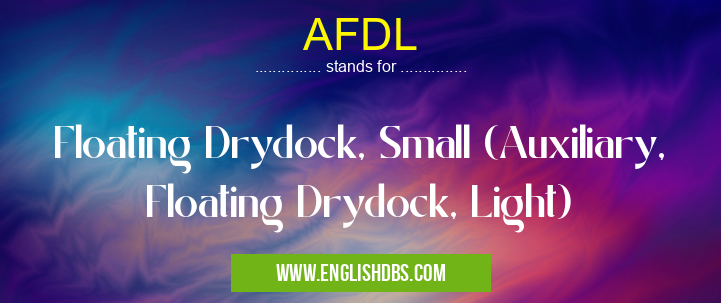What does AFDL mean in SHIPPING & SAILING
An AFDL (Floating Drydock, Small) is a type of vessel used for the maintenance and repair of smaller boats and ships. It has a rectangular hull and is designed to be flooded to allow ships to be floated into the dock, which can then be emptied so that repairs may be done.

AFDL meaning in Shipping & Sailing in Miscellaneous
AFDL mostly used in an acronym Shipping & Sailing in Category Miscellaneous that means Floating Drydock, Small (Auxiliary, Floating Drydock, Light)
Shorthand: AFDL,
Full Form: Floating Drydock, Small (Auxiliary, Floating Drydock, Light)
For more information of "Floating Drydock, Small (Auxiliary, Floating Drydock, Light)", see the section below.
Essential Questions and Answers on Floating Drydock, Small (Auxiliary, Floating Drydock, Light) in "MISCELLANEOUS»SHIPS"
What is an AFDL?
How long have AFDLs been in use?
AFDLs have been in use since the 1950s, however they have seen increased popularity as an economical way to maintain and repair larger vessels in recent years.
What are the benefits of using an AFDL?
One of the main advantages of using an AFDL is its mobility; it can easily be moved between ports for convenience or cost savings if needed. Additionally, it requires minimal personnel for operation compared with other dry docks making it a more affordable solution in some cases.
What types of vessels can be maintained and repaired in an AFDL?
Any small vessel such as fishing trawlers, tugboats, barges, yachts and pleasure craft of up to 40 feet in length can typically be accommodated by an AFDL.
Are there any restrictions on materials used when repairing vessels in an AFDL?
Generally speaking, only materials which will not damage the surface of the dock should be used when repairing vessels in an AFDL. This includes paints, sealants and caulking compounds which are suitable for use underwater.
How much does it cost to operate a floating drydock?
The cost to operate a floating drydock depends on factors such as size and typeof vessel being serviced as well as location. However, generally speaking they tend to be more economical than other alternatives due to their mobility and reduced staff requirements.
How big are most AFDLS?
Most Floating Drydocks, Small typically measure between 10m-20m (30ft-60ft) long with a beam 7m (22ft) wide.
Do I need any special equipment to operate an FMFDFS?
In most cases you will not need any special equipment beyond what is usually available on-board your vessel; however depending on what type of jobs you are undertaking it may be necessary to obtain additional tools or supplies specifically designed for working within the confines of the dock itself.
What safety measures should I take when operating a floating drydock?
When operating any type of drydocking facility there are certain safety rules which must always be followed including wearing protective gear such as life jackets or buoyancy suits where appropriate; having enough personnel on board to safely provide coverage throughout the entire job; ensuring all necessary tools and supplies are present before beginning work; following all local regulations pertaining to environmental protection or marine traffic; maintaining proper communication throughout operation; never entering water deeper than waist height without floatation support devices; regularly checking weather conditions prior during operation etc.
